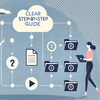
Instructional design is perceived as something separate from technical writing. Let’s take a closer look at this field and see for ourselves whether a line should be really drawn between techcomm specialists and instructional designers.
Definition of Instructional Design
Instructional design is a process of developing and delivering learning materials and everything in between – research, analysis, assessment. That’s what an instructional designer does, they create educational content using modern technology. There are different types of learning materials that can be delivered:
- Tutorial videos
- Learning courses
- User Guides
- Etc.
Anything sounds familiar? 🙂
Documentation Writing and Instructional Design
We can clearly see that technical writers are no strangers to some instructional design tasks. We can even sum up technical writing in a pretty similar way – the means to explain to someone how something works, to teach users a product or a service.
However, instructional design is much more education-focused (while in case of technical writing we are mostly interested in the clarity of given information, instructional writing searches for ways to really teach people something) and, thus, approaches to similar tasks of providing a user with knowledge on how something works are quite different, too.
Instructional design is more creative. Ways of delivering information are chosen according to the audience and task. For example, a learning course can include animation, slides, written materials, or even be delivered in the form of an educational game. This brings us to the question of skills a successful instructional designer will most likely possess as compared to a documentation writer.
Top Skills of Instructional Designer
- Understanding Adult Learning Methodologies
Any teacher should know learning methodologies in order to really teach somebody. There are certain specifics connected to learners’ age, knowledge level, the content itself that will define future educational materials.
Learning methodologies include information on how content is absorbed by our brain, how much new data each educational chunk should contain and how to make sure this data will be fully processed and memorized.
We see instructional design leaning towards the pedagogical field, while help authoring is mostly just trying to be as clear and precise as possible.
- Creativity + Visual Content Creation
Instructional designers are often faced with tasks that require a creative approach. In order to make learning more appealing, ideas need to be presented in some interesting manner. So, imagination should cooperate with learning methodologies here. And, to make all this happen, instructional design specialists require tools to work with imagery. They don’t have to do all the work, of course, but, at the same time, instructional designers should be able to sketch and create mockups.
Technical writers do use different editors for videos, gifs, screenshots, but in a more pragmatic way. Help authoring hardly ever requires creativity.
- Understanding Learning Assessment
This is kind of connected to learning methodologies, but this aspect certainly deserves special attention.
Instructional designers should understand how to assess users’ knowledge, what tools to use for that. That’s crucial for understanding how successful the educational content turned out to be, where excellent marks do not necessarily mean success, they can just mean that the topic is too easy. Correlation with what’s expected matters more.
Technical writers have some assessment tools for user guides, as well. But these metrics don’t test readers, they evaluate a doc team’s performance, rate usefulness of help topics and content readability.
Conclusion
Instructional design and technical writing are different areas that are getting closer with time. Technical writers are now moving towards deeper analysis of user experience and further usage of this knowledge to create more reader-focused technical documentation. Earlier, the focus was placed on content more. Besides that, some forms of content coincide between the two occupations, like video tutorials or user guides. We think that it would be useful for tech writers to collaborate with instructional designers to learn tips and tricks that work well for educating users.
Good luck with your technical writing!
ClickHelp Team
Author, host and deliver documentation across platforms and devices



